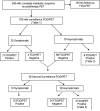Surveillance FDG-PET detection of asymptomatic recurrences in patients with cervical cancer
- PMID: 18929403
- PMCID: PMC4398307
- DOI: 10.1016/j.ygyno.2008.08.028
Surveillance FDG-PET detection of asymptomatic recurrences in patients with cervical cancer
Abstract
Objectives: To evaluate survival after detection of recurrent cervical cancer by FDG-PET in symptomatic versus asymptomatic patients.
Methods: This is a prospective registry study of 103 patients treated with definitive chemoradiation for advanced cervical cancer who demonstrated no abnormal FDG uptake (a complete metabolic response, CMR) on their 3-month posttherapy FDG-PET. Their median age was 48 years (range 26-84). The clinical stages were Ib in 38, IIa in 1, IIb in 39, and IIIb in 25. All patients underwent subsequent surveillance FDG-PET. Patients were grouped according to symptom status at the time of the surveillance FDG-PET. Recurrence sites and survival data were analyzed.
Results: The median time from the 3-month posttherapy FDG-PET to the first surveillance FDG-PET was 13 months. 25 patients (25/103; 24%) were symptomatic at the time of surveillance FDG-PET and 21 of these had FDG-PET findings indicative of recurrence. 78 patients (78/103; 76%) were asymptomatic and 9 of these had tumor recurrence detected by PET. All recurrences were confirmed by biopsy or radiologic progression. The recurrences in the 21 symptomatic patients were loco regional in 4 and distant in 17. The 9 asymptomatic patients had isolated loco regional disease in 8 and distant disease in 1. All patients received treatment for recurrence. The three-year cause-specific survival for symptomatic recurrences was 19% versus 59% for asymptomatic recurrences (p=0.09).
Conclusions: Surveillance FDG-PET can detect asymptomatic recurrent disease that is potentially amenable to salvage therapy. Prospective investigation of surveillance PET is warranted.
Figures



References
-
- Jemal A, Siegel R, Ward E, Hao Y, Xu J, Murray T, Thun MJ. Cancer statistics, 2008. CA Cancer J Clin. l2008;58:71–96. - PubMed
-
- Plummer M, Franceschi S. Strategies for HPV prevention. Virus Res. l2002;89:285–93. - PubMed
-
- Grigsby PW. The role of FDG-PET/CT imaging after radiation therapy. Gynecol Oncol. l2007;107:S27–9. - PubMed
-
- Ryu SY, Kim MH, Choi SC, Choi CW, Lee KH. Detection of early recurrence with 18FFDG PET in patients with cervical cancer. Journal of Nuclear Medicine. l2003;44:347–352. - PubMed
-
- Bodurka-Bevers D, Morris M, Eifel P, Levenback C, Bevers M, Lucas K, Wharton T. Posttherapy surveillance of women with cervical cancer: an outcomes analysis. Gynecologic Oncology. l2000;78:187–193. - PubMed

